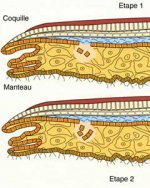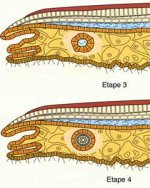Caitlin
Well-known member
I am referring solely to bivalve mollusks in this post.
So many sites use something similar to the following description for the formation of natural pearls:
However, here is Elisabeth Strack's (2006) definition: I think Strack's definition of how a pearl is formed is the best yet. pp 114, & 116-117.
She gives credit to Friederich Alverdes who in 1912-13 discovered the following:
Pearls are formed by the intrusion of epithelial cells into the mantle. The cause of that intrusion may be anything from a fish biting the mantle, thus carrying epithelial cells into the mantle to worms carrying epithelial cells into the mantle. In short, anything that puts epithelial cells into the mantle will form a pearl sack.
So the statement that reads
would better read "when a foreign object enters the mantle tissue carrying a few epithelial cells with it, a pearl sack is formed"- There may or may not be anything foreign lodged in the tissue for this to happen, but it is imperative that the epithelial cells be present in the mantle to form a pearl sack.
The description given above may fit natural mabe pearls which are formed against the shell, but not for free standing pearls.
So many sites use something similar to the following description for the formation of natural pearls:
Pearls form inside oysters, mussels, and clams (molluskan bivalves) when a small object becomes trapped inside the shell of the mollusk. Contrary to popular opinion, it is not sand that finds its way inside the shell but a small piece of clay, mud, worm, small crab, or parasite. When a foreign object enters the shell, as a self defense mechanism, the mollusk attempts to isolate the foreign object by secreting nacre (also known as mother of pearl).
However, here is Elisabeth Strack's (2006) definition: I think Strack's definition of how a pearl is formed is the best yet. pp 114, & 116-117.
She gives credit to Friederich Alverdes who in 1912-13 discovered the following:
Pearls are formed by the intrusion of epithelial cells into the mantle. The cause of that intrusion may be anything from a fish biting the mantle, thus carrying epithelial cells into the mantle to worms carrying epithelial cells into the mantle. In short, anything that puts epithelial cells into the mantle will form a pearl sack.
So the statement that reads
When a foreign object enters the shell
would better read "when a foreign object enters the mantle tissue carrying a few epithelial cells with it, a pearl sack is formed"- There may or may not be anything foreign lodged in the tissue for this to happen, but it is imperative that the epithelial cells be present in the mantle to form a pearl sack.
The description given above may fit natural mabe pearls which are formed against the shell, but not for free standing pearls.
Attachments
Last edited:


